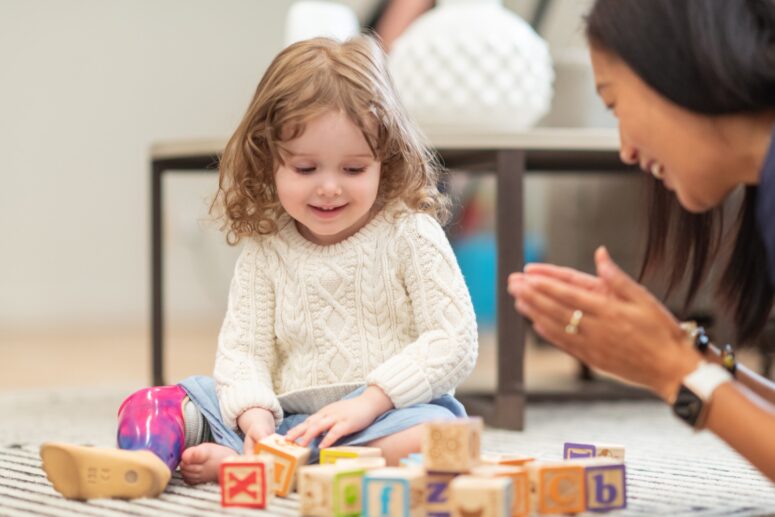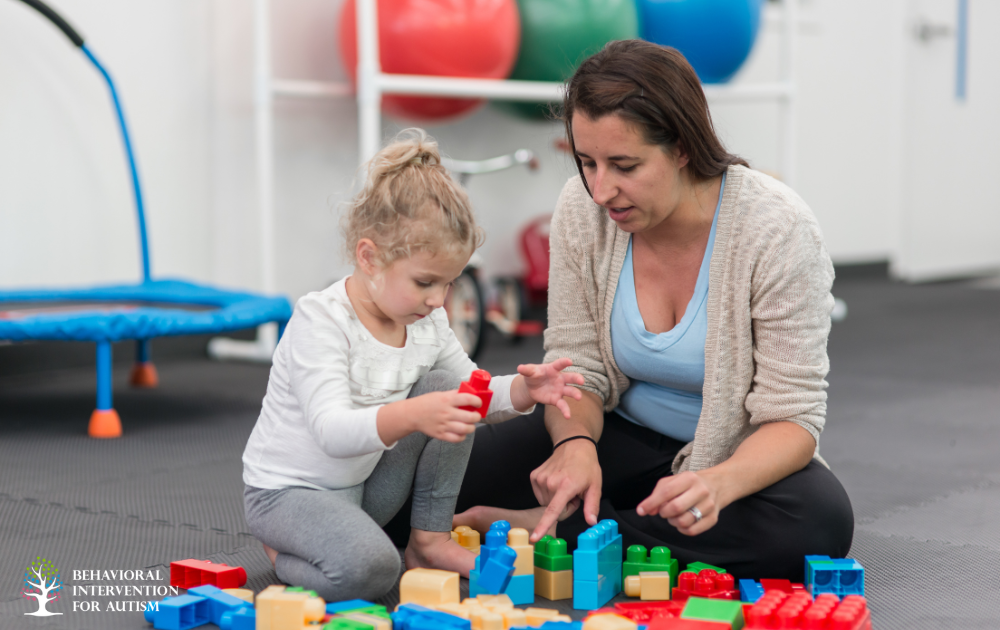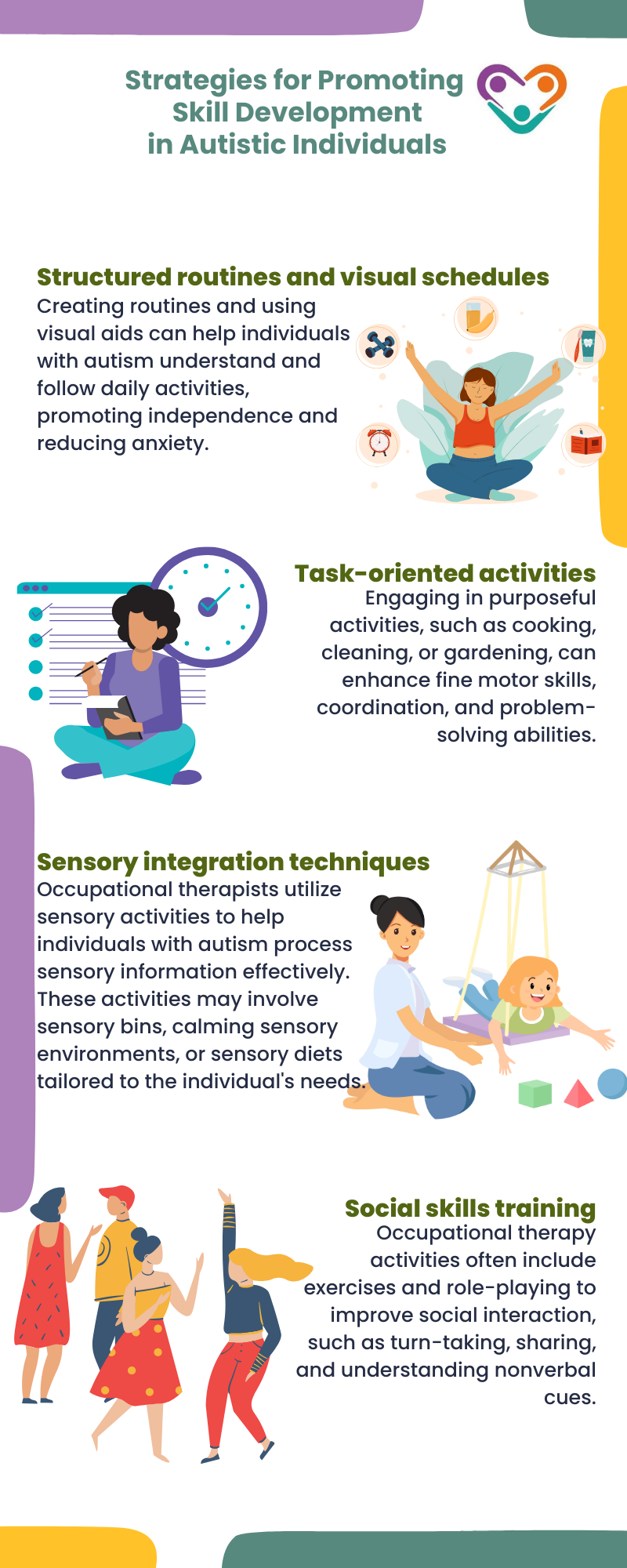
Table of Contents
Occupational therapy activities for autism are designed to support individuals in developing essential skills and achieving greater independence in their daily lives. These activities often incorporate play-based learning, which provides a fun and engaging way to acquire new skills.
Let’s have a look at what these activities are so individuals with autism can improve their social, motor, and cognitive abilities while also enhancing their overall well-being.
Play-Based Learning
Play-based learning is a central component of occupational therapy for autism. It involves engaging individuals in activities that are enjoyable and meaningful to them while targeting specific goals. Through play, individuals with autism can develop a wide range of skills, including communication, social interaction, problem-solving, and motor coordination.
During play-based therapy sessions, occupational therapists use various techniques and materials to create a supportive and stimulating environment. They may incorporate toys, games, puzzles, and interactive activities that encourage the development of specific skills.
By tailoring the activities to the individual’s interests and abilities, occupational therapists can effectively engage and motivate individuals with autism to participate actively in the therapy process.
Skill Development
Occupational therapy activities for autism focus on skill development to enhance an individual’s ability to perform daily activities and promote independence. These activities target areas such as self-care, fine and gross motor skills, sensory processing, and communication.
Occupational therapists employ a range of strategies and interventions to address underlying challenges and promote skill development. These may include:
Occupational therapy activities for autism are highly individualized, taking into account the unique strengths, challenges, and goals of each individual.
Obstacle Course Creation
Building an obstacle course at home can be a fun and effective way to promote gross motor skill development in individuals with autism. Obstacle courses can be tailored to individual needs and preferences, and they offer a range of benefits.
By creating an obstacle course, children can engage in activities that target skills such as jumping, climbing, crawling, and balancing. These activities help improve gross motor skills, coordination, balance, and body awareness.
Additionally, navigating through an obstacle course can enhance problem-solving abilities, planning skills, and spatial awareness.
Here is an example of an obstacle course layout:
- Jumping – Place cushions or foam mats for jumping from one to another.
- Crawling – Set up a tunnel or designate a crawling path using tape on the floor.
- Balancing – Create a narrow beam using a sturdy board or use a designated balancing beam.
- Climbing – Set up a small climbing wall or use sturdy furniture for climbing exercises.
Remember to ensure the safety of the obstacle course by removing any potential hazards and providing supervision as needed. Adjust the difficulty level of the activities based on the individual’s abilities and gradually introduce more challenging elements over time.
Cooking Together
Cooking activities provide an opportunity for individuals with autism to develop various skills, including fine motor skills, coordination, grasp, and social interaction. Cooking together promotes sensory exploration, following instructions, turn-taking, and communication.
Engaging in simple cooking tasks can help improve fine motor skills like finger and hand strength, dexterity, and coordination. Mixing ingredients, stirring batter, and using utensils require precise movements and can enhance manual dexterity.
Here are some cooking activities suitable for individuals with autism:
- Making Banana Muffins – Measure and mix ingredients to make a batch of delicious banana muffins.
- Pancake Art – Use pancake batter and different food coloring to create colorful and creative pancake designs.
- Sandwich Making – Assemble sandwiches using different fillings and practice cutting them into smaller portions.
When cooking with individuals with autism, provide clear and simple instructions, adapt the tasks to their abilities, and ensure safety measures are in place. Encourage communication, turn-taking, and provide positive reinforcement to make the activity enjoyable and rewarding.
Social Skills Building
Building social skills is an essential aspect of occupational therapy for individuals with autism. Occupational therapists utilize various techniques and interventions to help individuals better understand and engage in social interactions.
Here are some effective strategies to consider:
- Video-based interventions – Video clips can be used to address social skills, particularly perspective-taking, in children with autism. These videos help individuals understand emotions and different perspectives in an engaging and relatable way.
- Social stories – Occupational therapists often use social stories to teach individuals with autism about social situations and appropriate responses. These stories present scenarios in a structured and visual format, helping individuals understand social cues and expectations.
- Role-playing activities – Role-playing activities provide individuals with opportunities to practice social skills in a safe and structured environment. Occupational therapists create scenarios that mimic real-life situations, allowing individuals to practice social interactions and learn appropriate behaviors.
- Peer interaction groups – Occupational therapists may facilitate peer interaction groups, where individuals with autism can engage with their peers in a supportive and structured setting. These groups provide opportunities for socialization, collaboration, and the development of social skills.
Communication Activities
Communication is a fundamental aspect of social interaction, and occupational therapists work with individuals with autism to improve their communication abilities. Some activities that focus on communication development include:
- Augmentative and alternative communication (AAC) – Occupational therapists may introduce AAC systems, such as picture cards, sign language, or communication devices, to support individuals with autism in expressing their thoughts, needs, and emotions.
- Speech therapy exercises – Occupational therapists often collaborate with speech-language pathologists to address speech and language difficulties. Through speech therapy exercises, individuals with autism can work on articulation, vocabulary expansion, and pragmatic language skills.
- Social skills training – Occupational therapists incorporate social skills training into their therapy sessions to help individuals with autism develop effective communication strategies. This may involve teaching turn-taking, active listening, and appropriate non-verbal communication.
Occupational therapists play a crucial role in supporting individuals with autism in developing social skills and fostering meaningful connections.
By implementing these activities, occupational therapists can empower individuals with autism to navigate social interactions with confidence and success.
Interested in how our services here at Behavioral Intervention for Autism in Florida can make a difference for you or your loved one? Reach out to us today to explore how we can help.
Sources:
https://harkla.co/blogs/special-needs/occupational-therapy-activities-at-home
https://napacentre.com.au/ot-at-home
https://occupationaltherapygo.com/occupational-therapy-activities-for-children-with-autism
- 9 Common Obsessions of Children With Autism You Should Know - February 25, 2025
- What is Neurodiversity? A Guide to Embracing Differences - February 25, 2025
- Understanding Hyperfocus in Autism: What It Means and Why It Happens - February 25, 2025




